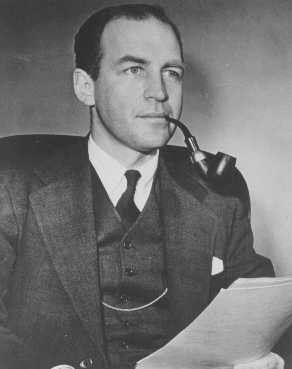War Refugee Board: Background and Establishment
On January 22, 1944, President Franklin D. Roosevelt announced a new policy to rescue and provide relief for Jews and other groups persecuted by Nazi Germany and its collaborators. The War Refugee Board was tasked with carrying out these programs. Its actions likely saved tens of thousands of lives.
Key Facts
-
1
The secretaries of State, War, and Treasury headed the War Refugee Board. It operated from January 22, 1944, to September 15, 1945. Most of the staff were Treasury Department employees.
-
2
The War Refugee Board streamlined the work of private relief agencies, helping them send money and resources into neutral and enemy territory. The board also placed American representatives in neutral nations to supervise projects and pressure the countries to welcome refugees.
-
3
The War Refugee Board was the first and only official American response to the crimes we now call the Holocaust. Winning World War II, however, remained the Allied priority.
Introduction
President Franklin D. Roosevelt established the War Refugee Board (WRB) with Executive Order 9417 on January 22, 1944. The WRB was tasked with the “immediate rescue and relief of the Jews of Europe and other victims of enemy persecution.” It operated as an independent government agency under the executive branch. President Harry S. Truman closed it with Executive Order 9614 on September 15, 1945.
After World War II, the WRB's first director, John Pehle, described the board as “little and late” in comparison to the enormity of the Holocaust. In the WRB’s final report, the staff estimated that they saved tens of thousands of lives, and aided hundreds of thousands more.
The Bergson Group and the Emergency Committee to Save the Jews of Europe
In the United States, increased public knowledge about Nazi atrocities against Jews in Europe prompted various groups to devise rescue proposals. These efforts took place both in the government and in the public sphere.
Public pressure rose, in part, thanks to the agitation of a group of Palestinian Jews led by Peter Bergson. (Bergson used a pseudonym instead of his birth name, Hillel Kook.) Earlier in the war, the group had tried to gain support in the United States to form an independent Jewish Army under Allied command. In the summer of 1943, however, they formed the Emergency Committee to Save the Jews of Europe. The Bergson group (as it became known) placed full-page ads in major newspapers to raise awareness of the ongoing mass murder of European Jews. They also sponsored elaborate public programs.
The Bergson group’s advertisements and petitions condemned what its members saw as the inaction of the United States, particularly the State Department. They called out the names of prominent people in the entertainment, religious, intellectual, business, and political communities. The group's stark language and brash tactics irked many in Congress and in the Roosevelt administration. Their methods also irritated Jewish community leaders.
In November 1943, members of Congress who supported the Emergency Committee’s recommendations sponsored identical bills in the House of Representatives and the Senate. The bill, which became known as the “Rescue Resolution,” challenged Roosevelt to establish a commission to devise and enact plans to rescue the Jews of Europe. The non-binding resolution passed unanimously in a Senate committee. It had not passed the full Senate or the House of Representatives by the time President Roosevelt created the War Refugee Board through an Executive Order.
Pressures within the Roosevelt Administration
As public pressure increased in summer and fall 1943, internal conflict developed within the Roosevelt administration. Tensions flared between the State Department, under Secretary Cordell Hull, and the Treasury Department, under Secretary Henry Morgenthau, Jr.
The World Jewish Congress had proposed funding relief for Jews in France and Romania and for the evacuation of Jews from Romania. This proposal prompted a long series of discussions and cables between both departments. Treasury Department officials eventually supported issuing a license to fund the relief effort. The State Department delayed and obstructed the plan, however. Their delays were a result of bureaucratic inertia and concerns about setting a precedent that would result in the approval of similar requests. State Department officials also worried that the money might fall into enemy hands.
The Treasury Department staff discovered a series of troubling cables from January and February 1943. These cables showed that the State Department had deliberately attempted to stop information about the mass murder of Jews from reaching the United States. By the end of 1943, staff at the Treasury Department had gathered enough information to present to Secretary Morgenthau. Leading the staff effort were General Counsel Randolph Paul and head of Foreign Funds Control John Pehle, who would later become the WRB's first director.
The Treasury officials spent weeks writing a scathing 17-page memo entitled “The Acquiescence of this Government in the Murder of the Jews.” They alleged obstruction by the State Department and warned in their introduction that
“Unless remedial steps of a drastic nature are taken, and taken immediately, I am certain that no effective action will be taken by this government to prevent the complete extermination of the Jews in German controlled Europe, and that this Government will have to share for all time responsibility for this extermination.”
Executive Order Establishing the War Refugee Board
On January 16, 1944, Secretary Henry Morgenthau, Jr., John Pehle, and Randolph Paul met with President Roosevelt at the White House. Pehle described the facts the Treasury staff had uncovered.
The Treasury officials presented Roosevelt with a draft executive order to establish a War Refugee Board tasked with the “immediate rescue and relief of the Jews of Europe and other victims of enemy persecution.” Oscar Cox, the administrator for Lend-Lease, which extended material aid to the Allies, assisted with drafting the order. For several months, Cox had been contemplating the idea of a relief agency supported by Lend-Lease funds.
Roosevelt approved the order with minor changes. Executive Order 9417 establishing the WRB was issued on January 22, 1944. It stated, “It is the policy of this government to take all measures within its power to rescue the victims of enemy oppression who are in imminent danger of death and otherwise to afford such victims all possible relief and assistance consistent with the successful prosecution of the war.”
Composition of the Board

The WRB was nominally headed by Secretary of War Henry Stimson; Secretary of State Cordell Hull (after November 1944, Edward Stettinius); and Secretary of the Treasury Henry Morgenthau, Jr. In actuality, the WRB was mostly a Treasury Department operation. Most of the staff came from the Treasury Department, and the WRB offices were located in the Treasury building.
John Pehle was appointed as the WRB's first director. He immediately gathered a staff to help run the office in Washington, and appointed overseas representatives. Brigadier General William O'Dwyer served as the director of the WRB from January 1945 until the dissolution of the board in September 1945.
The board's administrative funding came from the President's Emergency Fund and through Congressional appropriations. The WRB streamlined the work of private aid organizations, most of them Jewish organizations, allowing them to fund relief and rescue projects in Europe.
Critical Thinking Questions
- What pressures and motivations may have delayed the formation of a government program to aid the endangered Jews of Europe?
- What pressures and motivations spurred agencies and individuals to push for such a program?
- Investigate different methods and programs that governments, coalitions, and NGOs (non-governmental organizations) use to aid endangered populations.

